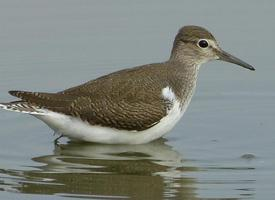
Greutăți și măsuri
| Lungime | de la 20 la 22 cm |
|---|---|
| Greutate | de la 35 la 85 g |
| Lungimea anvergurii aripilor | de la 33 la 40 cm |
Starea de conservare
| Neînfricat |
Descrierea animalului
The Common Sandpiper, scientifically known as Actitis hypoleucos, is a captivating bird species belonging to the family Scolopacidae, which is renowned for its diverse array of waders or shorebirds. This small and elegantly patterned bird is a marvel of nature, known for its distinctive behavior and wide-ranging migratory patterns that captivate birdwatchers and ornithologists alike.Physical Description:
The Common Sandpiper is a dainty bird, measuring about 18-20 cm in length, with a wingspan of approximately 32-35 cm. It weighs around 40-60 grams. The bird exhibits a slender, streamlined body conducive to its active lifestyle. Its plumage is predominantly brown on the upperparts, blending seamlessly with its natural surroundings. The underparts, in contrast, are a crisp white, accented with a distinctive white shoulder stripe that is visible in flight. The bird's head features a patterned brown crown and a white supercilium (eyebrow) that stretches from the bill to beyond the eye, giving it a striking appearance. Its bill is straight and of medium length, suited for foraging, while its legs are relatively long and greenish-yellow, enabling it to wade through shallow waters with ease.
Behavior and Diet:
The Common Sandpiper is a solitary bird for most of the year, except during the breeding season. It exhibits a characteristic 'bobbing' motion, known as 'teetering', where it nods its head and tail up and down while foraging along riverbanks, lakeshores, and wetlands. Its diet primarily consists of small invertebrates, including insects, crustaceans, and mollusks, which it adeptly picks from the mud or shallow water.
Habitat and Distribution:
This species exhibits remarkable adaptability, inhabiting a wide range of wetland habitats, from freshwater rivers and lakes to estuaries and coastal shores. The Common Sandpiper breeds across much of Europe and Asia, preferring open landscapes near water bodies for nesting. It constructs its nests on the ground, hidden among vegetation. During the winter months, it migrates southwards to Africa, South Asia, and Australasia, showcasing its incredible endurance and navigational skills.
Migration and Conservation:
The migratory journey of the Common Sandpiper is a testament to its resilience, covering thousands of kilometers across continents. Despite facing threats from habitat loss and pollution, the Common Sandpiper has maintained a stable population, thanks in part to conservation efforts aimed at preserving wetland habitats. It is listed as Least Concern by the International Union for Conservation of Nature (IUCN), indicating that, currently, it is not at immediate risk of decline.
In summary, the Common Sandpiper is a fascinating bird that captures the imagination with its graceful appearance, intriguing behaviors, and extensive migratory habits. It plays a vital role in the ecosystem, acting as a bioindicator for the health of wetland habitats. As such, the conservation of this species and its environment is crucial for maintaining biodiversity and ecological balance.
Animale similare
Fotografii noi cu animale
Top 10 animale
- Dolphin gull (Leucophaeus scoresbii)
- Diana monkey (Cercopithecus diana)
- Galápagos tortoise (Geochelone nigra complex)
- Moustached guenon (Cercopithecus cephus)
- Japanese spider crab (Macrocheira kaempferi)
- Colossal squid (Mesonychoteuthis hamiltoni)
- Stone loach (Barbatula barbatula)
- Fox tapeworm (Echinococcus multilocularis)
- Japanese macaque (Macaca fuscata)
- Barbary macaque (Macaca sylvanus)


